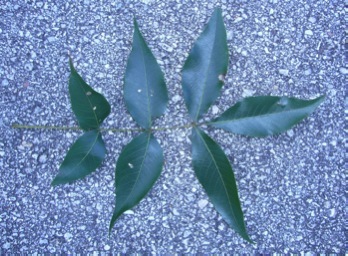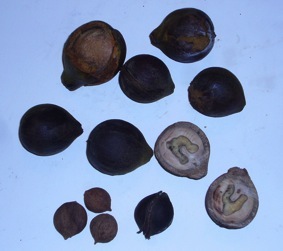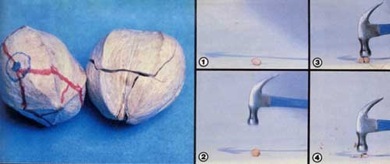Cayra coffee, or Hickory Java
Hickories are not a migraine, but when you’re learning trees hickories can be a headache.
Just as plums and cherries are bothin the Prunus genus hickories and pecans are bothin in the Carya genus, and both in the greater Walnut family. Fortunately while there are a lot of Prunus there are only about a dozen Carya in the United States, some say more, some say less . You really don’t have to tell them apart any more than you do oaks. Be happy they aren’t Hawthorns, even the experts can’t tell the thousand of them apart.
For many years most of my foraging was looking down, not up. To be more specific, other than acorns I kind of avoided the nut-bearing trees. But there comes a point in which you realize while greenery is fine, nutrition comes mainly from roots and nuts. When foraging is a hobby greens and berries will do. When one begins to ask, “can I live off this stuff?” then roots and nuts become more important. That’s when you seriously study roots and nut-bearing trees. That’s when you run in to hickories and pecans. Not only that but the line between hickories and walnuts is thin and that can be confusing as well.
The easiest thing to do is learn which ones grow in your area and then find them. Which species is rather secondary, except for flavor. As for edibility, like oaks and pines there is no poisonous Carya and no poisonous look alikes. That makes life easy. When you find a hickory nut it will either be edible, or hopefully edible after leeching. The crux, of course, is make sure you have a hickory or a relative, even if you don’t know exactly which one.
Some hickories are esteemed — used in ice cream and the like — and others are listed as “not edible.” That is not toally accurate. They are edible, but they may be astringent or bitter. Often those qualities can be leeched out.
Two hickories that are common here are the Pignut Hickory, Carya glabra, (KAIR-ee-uh GLAY-bruh) and the Water Nut Hickory, Carya aquatica (KAIR-ee-uh a-KWA-ti-ka.) One reads the first is not esteemed and the latter is not edible. Actually, both were used as food by Native Americans.
The Pignut Hickory is so called because when cut the nut resembles the front aspect of a pig’s nose. The Water Hickory is so hailed because it likes to grow in damp areas and is the tallest of all hickories, some times as much as 150 feet. It is usually bitter, and the nutmeat resembles the coloring of a pecan. It can be eaten, though, and you can also leach out the bitterness like you do with acorns. The Water Nut Hickory’s major claim to fame is it is the hickory wood used to flavor foods by smoking and in barbecues. Other Carya include C. floridana, C. tomentosa and C. illinoensis, which is the well-known Pecan. It is not native locally but is planted here and there (Eagle Lake Park in Largo is one location.) C. floridana actually grows only a few miles from me in Wekiva Springs State Park. It has very small nuts and completely covered with prickles.
The big issues with hickories is how to get at the nutmeat. There are several ways. You can buy motorized and hand-driven machines that do the work. You can learn how to hit them with a hammer and pick the meat out. You can do what the Indians did. They pulverized the entire nut, added water, then filtered out the particulates leaving hickory milk called pawcohiccora which was shortened by settlers to pohichery giving in time “Hickory.”
Sometimes instead of adding a lot of water they would sift until few shell bits remained. That can be squeezed into a ball. Then they put the ball in a small amount of hot water, to float it. The shell bits sink and the rest is poured off for a soup base.
As for shelling by hand, remove husks if they are not off already. Wash and dry the shells. Lay the hickory nut down on its narrowest side and hit the closer seam with a hammer one third the way back from the stem end. It takes some practice. Second method: If you soak the nuts for an hour or more and work with them wet they will open without shattering. Either method is a personal preference. Some say you get a greater yield by soaking them. Don’t try to use a lever-type nutcracker. Either the nuts will be too hard or way too soft for that kind of nutcracker to work well.
The name Carya comes the Greek word ka-RI-thee, which is Greek for the hickory nut that they have in Europe, though it is a bit more complex than that. The walnut is kaREEa, named after Carya, daughter of the king of Laconia who was changed into a walnut tree by Bacchus. Glabra is bald, meaning no hair on the leaves or stems. Aquatica, of the water.
Some recipes are on the bottom of the page.
Green Deane’s “Itemized” Plant Profile
IDENTIFICATION: A tree from 30 to 150 feet. Vertical furrowed bark, sometimes shaggy. Leaves usually leaflets of five or seven, two to four on the main stem, three leaflets splayed at the end, terminal leaflet often the largest. Not be confused with an ash. Hickory leaves alternate whereas the ash leaf is opposite.
TIME OF YEAR: Fall, usually october or whenever the tree drops them and for some time after that.
ENVIRONMENT: Varies with variety from dry scrub to root-in-water swamps.
METHOD OF PREPARATION: Raw or roasted as a nut, a flour, a meal in water. No toxic look alikes. Bitter hickories can be leached like acorns.
Recipes
by Linda Schaalma and her parents Ray and Virginia Pamperin, Juneau Wisconsin
Hickory Nut Cake Makes 12 to 16 servings
½ cup (1 stick) butter
1 ½ cups sugar
2 ½ cups sifted cake flour
1 tablespoon baking powder
¼ teaspoon salt
1 cup milk
1 teaspoon vanilla extract
1 cup chopped hickory nuts
5 egg whites, stiffly beate
Hickory nut filling (see recipe)
Boiled frosting to cover 3-layer cake
Additional hickory nuts for garnish (optional)
Preheat oven to 350 degrees. Grease and flour three (9-inch) round cake pans.
Prepare cake: In mixing bowl, cream butter. Gradually beat in sugar. Resift flour with baking powder and salt. Add to butter-sugar mixture alternately with milk, to which vanilla has been added. Add nuts and fold in stiffly beaten egg whites.
Divide batter evenly among prepared pans. Bake in preheated oven 20 minutes, or until cake tester inserted into center of each layer comes out clean.
Let cool in pans on rack 10 minutes, then carefully remove from pans and let cool completely on rack. Run knife around edge of pan to loosen sides and remove from pan.
Prepare hickory nut filling. Transfer one cooled cake layer to serving plate, top with half the filling, then another layer, the remaining filling, and finally, the last cake layer.
Prepare boiled frosting. Pour over cake, spreading evenly with back of spoon. Work quickly; frosting will crease as soon as it is firm. If frosting is not beaten long enough, it will run; if beaten too long, it will not be smooth. Frosting beaten too long may be improved by adding a few drops of lemon juice or boiling water. Note: This frosting is soft and has a glossy surface. If decorating the cake with nuts, place nuts on frosting as soon as it is spread.
Hickory nut filling:
3 cups sugar
1 cup light cream or half-and-half cream
1 teaspoon corn syrup
1 tablespoon butter
1 cup chopped hickory nuts
To make filling, cook sugar, cream and corn syrup in saucepan over medium to medium-high heat, stirring constantly, until temperature on candy thermometer reaches 238 degrees, or a soft ball is formed when dropped into cold water, about 12 to 15 minutes. Add butter and let cool. Beat with mixer on high speed until creamy. Stir in nuts.
Hickory Nut Pie Makes 8 servings
Here’s another family recipe from Schaalma for a pie that substitutes hickory nuts for pecans:
Pastry for one (9-inch) deep-dish pie
3 eggs
1 scant cup light corn syrup
¼ cup (½ stick) butter, melted
½ cup packed brown sugar
1 tablespoon pure maple syrup or ½ teaspoon maple flavoring
1 heaping cup coarsely chopped hickory nuts
Sweetened whipped cream
Preheat oven to 350 degrees.
Fit pastry into 9-inch deep-dish pie pan.
In bowl, beat eggs slightly. Add corn syrup and melted butter; beat well until smooth. Stir in brown sugar, maple syrup and nuts; mix thoroughly. Place pie pan on baking sheet and pour filling into pie shell; if it gets too full, add the last cup after you’ve put the pan in the oven.
Bake in preheated oven 45 to 55 minutes or until middle is set. Nuts will have risen to the surface. Cool to room temperature or chill thoroughly. Serve with whipped cream.
Customer Alverna Filter of Cascade recently shared this recipe for a crisp and nutty butter cookie with Schaalma. Filter told Schaalma in a note with her hickory nut order that she bakes these cookies to ship to her grandson, who is serving in the military in Iraq.
Hickory Nut Refrigerator Cookies Makes about 4 dozen
1 cup (2 sticks) butter, room temperature
1 egg
1 cup sugar
1 teaspoon vanilla extract
2 cups flour
½ teaspoon baking soda
¼ teaspoon salt
1 cup chopped hickory nuts
In bowl, cream butter. Add egg and beat until fluffy. Beat in sugar and vanilla. Stir in flour, baking soda and salt, then hickory nuts. Divide in half and shape into two logs. Wrap in wax paper and refrigerate 1 to 2 hours. Also wrap in plastic for longer storage, or to freeze.
When ready to bake cookies, preheat oven to 350 degrees. Slice dough into 1/8-inch-thick slices and place on ungreased cookie sheet 2 inches apart. Bake in preheated oven 10 to 15 minutes, until light golden on the bottom.
Note: These freeze well both before and after baking.
This recipe from a www.prodigalgardens.info
Maple Hickory Apple Crisp Makes 15 servings
8 cups sliced apples (9 or 10 medium-size apples)
1 tablespoon lemon juice
3 teaspoons ground cinnamon (divided)
3 tablespoons flour
½ cup water or apple juice
1 cup rolled oats
1 cup whole-wheat flour
1 cup packed brown sugar
1 cup hickory nuts (or chopped walnuts)
1 cup (2 sticks) butter, room temperature
¼ to ½ cup pure maple syrup
Whipped cream or vanilla ice cream (optional)
Preheat oven to 375 degrees. Grease 13-by-9-inch baking pan.
Peel, core and dice apples. In large bowl, toss apples with lemon juice, 1 teaspoon of the cinnamon and the flour. Transfer to prepared pan and add the ½ cup water or apple juice.
Chop oats coarsely in food processor or blender. To oats, add flour, brown sugar, remaining 2 teaspoons cinnamon and the nuts. Pulse until thoroughly mixed together. Add butter and mix until it resembles coarse bread crumbs. (Filling may seem too wet, resembling a paste – don’t get discouraged if this happens, just spread it as evenly as you can; it will be fine.)
Spread topping evenly over sliced apples. Drizzle maple syrup over topping.
Bake in preheated oven 45 minutes, or until topping is brown and apples are bubbly. If desired, serve with whipped cream or ice cream
Hickory Wild Rice Stuffing Makes 12 servings
Water
1¼ cups dry wild rice
8 ounces ground sausage (optional)
1 tablespoon butter
2 large celery ribs, diced
1 medium onion, minced
1 teaspoon salt
½ teaspoon black pepper
2 cups chopped hickory nuts
Follow directions on wild rice package and cook rice until very tender.
In skillet, cook sausage, if using, breaking it up with a spoon, until well done. Add to rice. Add butter, onion and celery to sausage drippings in skillet and sauté until tender. Add sautéed ingredients to rice and sausage mixture, along with salt and pepper and nuts. Mix together well.
Use to stuff a chicken or turkey (¾ cup per pound of poultry), then roast accordingly, until meat is done and stuffing has reached 165 degrees. (Or, place in a 13-by-9-inch greased casserole dish and bake at 325 degrees for 20 minutes or until thoroughly hot.)
Variation: If desired, add about 1 cup sliced mushrooms and/or 1 cup diced apples or cranberries…
Hickory Nut “Coffee”
Roast about six huled, larva-less hickory nuts for 15 minutes at 350. remove and let them cool. Do not cook them longer or at a higher temperature without first scoring them so heat can escape. Split the shells. Put in pan with one to two cups of water., Bring to boil. When water turns golden, strain into cup and enjoy/





